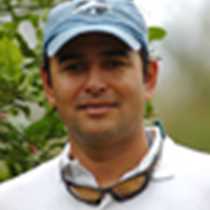Isabela & Fernandina Islands
The sun shone through on a calm — though partially cloudy — horizon making us very happy because we had the ideal conditions to find marine mammals. For about half an hour we identified birds: Galápagos shearwater, dark rumped petrel, wedge rumped storm petrel, noddy tern, magnificent frigate, Nazca booby, swallow tailed gull etc. Then to everyone’s delight we found a small pod of striped dolphins! This is a special sighting because they are very rarely seen in Galápagos. We were able to get close enough to see many of the details that characterize this species. Staff and guests alike were thrilled with this wonderful find.
After much wandering off course behind the dolphins, our Captain Wilfred Chavez navigated toward the equator line and Ecuador Volcano. Ecuador Volcano is a perfect cross section of a huge shield volcano that collapsed into the sea hundreds of thousands of years ago. We anchored at Punta Vicente Roca where we boarded our pangas, or Zodiacs, to go out and explore along the coastline. This area was teeming with wildlife. Marine turtles were popping their heads out of the water for a breath here and there, Galápagos penguins were sunning themselves on the lava rocks posed for our cameras, and the ocean sunfish, or Mola mola, which were a bit of a task to find this morning, stayed at the surface so we all got a great look at this strange fish.
In the afternoon we repositioned the Islander to Fernandina Island, which is the youngest island in the archipelago and a very pristine place. In fact, it’s one of the very last untouched islands left in the world. It was wonderful to explore the barren lava fields, fringed along the coast with basking iguanas. We observed flightless cormorants, Sally lightfoot crabs, and a top land predator, the Galápagos hawk, which stood 10 feet away from us and scavenged a recently deceased sea lion pup. It was time to return to “our home away from home” to watch the orange ball of the sun disappear behind this enchanted isle.
The sun shone through on a calm — though partially cloudy — horizon making us very happy because we had the ideal conditions to find marine mammals. For about half an hour we identified birds: Galápagos shearwater, dark rumped petrel, wedge rumped storm petrel, noddy tern, magnificent frigate, Nazca booby, swallow tailed gull etc. Then to everyone’s delight we found a small pod of striped dolphins! This is a special sighting because they are very rarely seen in Galápagos. We were able to get close enough to see many of the details that characterize this species. Staff and guests alike were thrilled with this wonderful find.
After much wandering off course behind the dolphins, our Captain Wilfred Chavez navigated toward the equator line and Ecuador Volcano. Ecuador Volcano is a perfect cross section of a huge shield volcano that collapsed into the sea hundreds of thousands of years ago. We anchored at Punta Vicente Roca where we boarded our pangas, or Zodiacs, to go out and explore along the coastline. This area was teeming with wildlife. Marine turtles were popping their heads out of the water for a breath here and there, Galápagos penguins were sunning themselves on the lava rocks posed for our cameras, and the ocean sunfish, or Mola mola, which were a bit of a task to find this morning, stayed at the surface so we all got a great look at this strange fish.
In the afternoon we repositioned the Islander to Fernandina Island, which is the youngest island in the archipelago and a very pristine place. In fact, it’s one of the very last untouched islands left in the world. It was wonderful to explore the barren lava fields, fringed along the coast with basking iguanas. We observed flightless cormorants, Sally lightfoot crabs, and a top land predator, the Galápagos hawk, which stood 10 feet away from us and scavenged a recently deceased sea lion pup. It was time to return to “our home away from home” to watch the orange ball of the sun disappear behind this enchanted isle.




